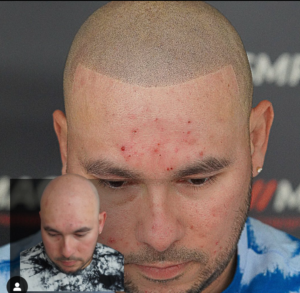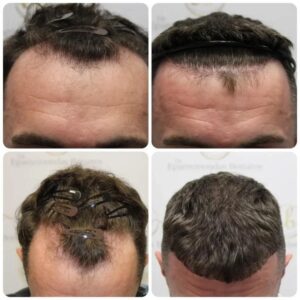Welcome to our comprehensive guide on recognizing the early signs of receding hairline. Hair loss can be a distressing experience for both men and women, but identifying the problem early can significantly improve your chances of finding effective solutions. This blog post will explore the five early signs of receding hairline, why they occur, and what steps you can take to address the issue.
Table of Contents
Key Takeaway
Recognizing the early signs of receding hairline is crucial for timely action and effectively addressing the issue.
Understanding the signs such as thinning hair, widening forehead, receding temples, excessive shedding, and miniaturized hair can help you seek the right professional advice, adopt a healthy lifestyle, consider medical treatments, or explore non-medical solutions to manage and potentially restore your hairline.
Early intervention is key to managing hair loss and maintaining overall hair health.
Understanding Receding Hairline
Before delving into the early signs of receding hairline, it’s important to understand what a receding hairline is and what causes it.
A receding hairline, also known as male pattern baldness or androgenetic alopecia, is a gradual hair loss pattern that typically starts at the temples or the crown of the head.
Both genetic and hormonal factors influence it, although other factors like age, stress, and poor hair care practices can exacerbate the condition.

The Top 5 Early Signs of Receding Hairline
Recognizing the signs of receding hairline is crucial for early intervention and effective management of hair loss. Here are some common signs to look out for:
1. Thinning Hair:
One of the earliest indicators of a receding hairline is thinning hair. As the hair follicles become more sensitive to dihydrotestosterone (DHT), a hormone linked to hair loss, they produce thinner and weaker hair strands.
You may notice that your hair appears less dense or that your scalp is more visible in certain areas. Common areas affected by thinning include the crown of the head and the temples. Pay attention to changes in the texture and density of your hair to identify this early sign.
2. Widening of the Forehead:
As the hairline recedes, the forehead may appear wider than before. The hairline gradually moves backward, leaving a more prominent forehead. This change is often more noticeable when you compare older photographs.
If you observe a more prominent forehead, with the hairline moving further back, it could be an early sign of a receding hairline.
3. Receding Temples:
The temples, located on the sides of the forehead, are particularly susceptible to hairline recession.
As a receding hairline progresses, the temples may become more visible, leading to a more pronounced “M” shape in your hairline.
Monitor the temple area for signs of hair loss or thinning. You may notice that the hair in this area becomes sparser and shorter.
4. Excessive Hair Shedding:
While it’s normal to lose some hair daily, excessive hair shedding can be a sign of a receding hairline. If you notice an increase in the amount of hair you find on your pillow, in the shower drain, or on your hairbrush, it’s worth monitoring.
Excessive shedding can indicate an underlying issue contributing to hair loss. Factors like hormonal imbalances, nutritional deficiencies, or stress can trigger increased hair shedding.
5. Miniaturized Hair:
Miniaturized hair refers to hair strands that become thinner and shorter over time. This is a common characteristic of a receding hairline.
As the hair follicles shrink and produce thinner hairs, you may notice that some regions of your hair appear finer, weaker, and lack the usual thickness.
These miniaturized hairs are more prone to falling out and are less likely to regrow.
Stages of Receding Hairline
The receding hairline is a progressive condition that typically occurs in stages. Understanding these stages can help you identify the severity of your receding hairline and determine appropriate steps for management and treatment.
Here are the stages of receding hairline:
- Stage 1: The hairline begins to recede at the temples. This is the earliest stage of receding hairline, and it is often not noticeable.
- Stage 2: The hairline continues to recede at the temples, and a V-shaped gap may start to form between the temples and the rest of the hairline.
- Stage 3: The hairline continues to recede, and the V-shaped gap becomes more pronounced. The hairline may also start to recede at the top of the head.
- Stage 4: The hairline recedes significantly, and the V-shaped gap becomes very pronounced. The hairline may also recede to the point where there is a large bald spot on the top of the head.
- Stage 5: The hairline recedes completely, and the person is completely bald.
It is important to note that the stages of receding hairline can vary from person to person. Some men may progress through the stages more quickly than others. There is no way to prevent receding hairline, but treatments are available that can help slow down or even reverse the hair loss.

Risk Factors of a Receding Hairline
There are some risk factors for receding hairline, including:
- Age: Receding hairline is most common in men in their 20s or 30s.
- Family history: If you have a family history of receding hairline, you are more likely to develop it yourself.
- Medical conditions: Some medical conditions, such as thyroid problems, can increase the risk of receding hairline.
What Can You Do When You Notice the Signs of Receding Hairline?
When you notice the signs of receding hairline, you must take proactive steps to manage and address the issue. Here are some actions you can take when you notice the signs of receding hairline:
A. Seek Professional Advice:
If you suspect you have a receding hairline, it’s essential to consult with a healthcare professional or a dermatologist who specializes in hair loss. They can assess your condition, determine the underlying causes, and recommend suitable treatment options.
Early intervention can help slow down or even reverse hair loss, so don’t hesitate to seek expert guidance. The specialist may perform a thorough examination, review your medical history, and possibly order blood tests or a scalp biopsy to understand your hair loss comprehensively.
B. Hair care and Lifestyle Changes:
Maintaining a healthy lifestyle is crucial for promoting hair health and potentially slowing down hair loss. Ensure you consume a balanced diet rich in vitamins, minerals, and proteins that support hair growth.
Include foods like leafy greens, lean proteins, nuts, and seeds in your diet. Reduce stress levels through relaxation techniques, exercise, or hobbies, as chronic stress can contribute to hair loss.
Additionally, practice good hair care habits, such as using mild shampoos that are free of sulfates and harsh chemicals, avoiding excessive heat styling, and being gentle while brushing or combing your hair to minimize hair breakage.
C. Medical Treatments and Procedures:
Various medical treatments are available for receding hairlines, including medications and surgical procedures. Medications like minoxidil (Rogaine) and finasteride (Propecia) are FDA-approved for treating hair loss.
Minoxidil is a topical solution that promotes hair regrowth, while finasteride is an oral medication that helps inhibit the conversion of testosterone to DHT.
These medications can effectively slow down hair loss and promote regrowth in some individuals, but they may have specific side effects. Hence, consulting with a healthcare professional before starting them is crucial.
Surgical options like hair transplantation or restoration techniques can be considered in more advanced cases. These procedures involve moving healthy hair follicles from donor areas to the thinning or balding areas, providing a long-lasting solution to hair loss.
D. Non-Medical Solutions:
If you prefer non-medical approaches or want to complement medical treatments, cosmetic options are available to conceal hair loss temporarily. Hair fibers, concealers, or styling techniques like strategic haircuts can create the illusion of fuller hair.
These solutions work by attaching to the existing hair or scalp to provide additional volume and coverage. However, it’s important to note that these solutions do not address the underlying causes of hair loss and may require regular maintenance or touch-ups.
FAQs:
How do I tell if my hairline is receding?
Some signs that your hairline may be receding include:
- Thinning temples. This is one of the most common signs of receding hairline. As the hair follicles in the temples weaken, they produce thinner and shorter hairs. Over time, this can lead to a noticeable gap between the temples and the rest of the hairline.
- Widening part. The part in your hair is the line where your hair is parted down the middle. If you notice that your part is getting wider, this could be a sign of hair loss.
- Thinning on top of the head. Hair loss can also occur on the top of the head. This is often the first sign of male pattern baldness, a common type of hair loss affecting men.
- Hairline recession. This is the most apparent sign of receding hairline. As the hair follicles in the front of the hairline weaken, they start to produce thinner and shorter hairs. Over time, this can lead to the hairline receding from the temples.
- Bald spots. Sometimes, hair loss can occur in patches, leaving bald spots on the scalp. This is less common than other types of hair loss, but it can be a sign of a more serious underlying medical condition.
If you notice any of these signs, you must see a doctor to rule out any underlying medical conditions.
Can a receding hairline regrow?
In some cases, a receding hairline can regrow. This is more likely to happen if a temporary condition, such as stress or medication side effects, causes hair loss. However, if the hair loss is caused by genetics, it is less likely that the hairline will regrow.
How can I regain my hairline?
The best way to regain your hairline will depend on the cause of your hair loss. If the hair loss is caused by a temporary condition, such as stress or medication side effects, the hairline may regrow on its own once the underlying condition is treated. However, if the hair loss is caused by genetics, some treatment options can help slow down or even reverse the hair loss.
Some of the treatment options for regaining a receding hairline include:
- Hair loss medications. Finasteride and minoxidil are two FDA-approved medications that can help to slow down or even reverse hair loss.
- Hair loss treatments. Laser therapy and hair transplantation are other treatment options that can help regrow hair.
- Changing your hairstyle. If you are concerned about your receding hairline, you can change your hairstyle to camouflage it. Several hairstyles can help to hide a receding hairline.
When does receding hairline start?
The age at which receding hairline starts can vary from person to person. However, it is most common for men to start experiencing hair loss in their 20s or 30s. In some cases, men may begin experiencing hair loss even earlier.
If you are concerned about your hairline, seeing a doctor to rule out any underlying medical conditions is vital. They can also help you to determine the best treatment options for you.
Conclusion
Recognizing the early signs of receding hairline is the first step toward addressing the issue effectively. When you become aware of the signs of receding hairline, like thinning hair, widening forehead, receding temples, excessive shedding, and miniaturized hair, you can take timely action.
Whether seeking professional advice, adopting a healthy lifestyle, considering medical treatments, or exploring non-medical solutions, options are available to tackle a receding hairline. Early intervention can make a significant difference in managing hair loss and maintaining overall hair health.
With the right approach and treatment, you can take control of your receding hairline and promote hair regrowth.
So, click here to contact a healthcare professional for your help and guidance.


